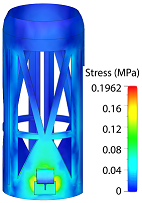Optimal Leg Height of Landing Legs to Reduce Risk of Damage from Regolith Ejecta by Retrorocket Exhausts
DOI:
https://doi.org/10.55672/hij2023pp17-23Keywords:
Engineering Mechanics, Aerospace and Aeronautical Engineering, Interplanetary Rockets, Landing Module, RetrorocketAbstract
Over the past decade, there has been a rapid increase in rocket launches. 2022 was a record-breaking year for the aerospace industry, with 180 successful rocket launches into orbit, 44 more than the previous year. Reducing as many risks as possible is essential as interplanetary rocket launches and reusable booster landings become more frequent. One such risk occurs when a rocket/booster lands. During the landing process, the retrorockets spray debris from the loose ground, which may damage the rocket/landing module. Retrorockets are rocket engines that provide a thrust opposing the spacecraft’s motion, causing it to decelerate. This paper studies the effect of landing leg height on ejecta velocity, the volume of debris ejected, and ground surface temperature change. Four landing leg heights were tested with an Estes® E-16 consumer model rocket motor: 0 mm, 50 mm, 75 mm, and 100 mm. The experiment suggests that the optimal height above the ground’s surface for a simulated landing module based on the volume and velocity of the ejecta is 50 mm. Landing legs that elevate a model rocket this height create an average crater volume of 610.5 mL and a max crater diameter of 10.34 cm. After determining the optimal height, a landing leg system was developed. This system was attached to an Aerodactyl TS® model rocket and utilized landing legs that elevated the rocket to a height of 50 mm above the ground at landing.
Downloads
References
[1] C. M. Donohue, P. T. Metzger, and C. D. J. a. p. a. Immer, "Empirical Scaling Laws of Rocket Exhaust Cratering," 2021.
[2] P. T. Metzger et al., "Cratering of Soil by Impinging Jets of Gas, with Application to Landing Rockets on Planetary Surfaces," 2021.
[3] B. Wang. (2022). SpaceX reusable rocket costs versus airplanes. Available: https://www.nextbigfuture.com/2022/02/spacex-reusable-rocket-costs-versus-airplanes.html
[4] A. J. N. Witze, "2022 was a record year for space launches," Nature News, 2023.
[5] (2023). Apogee Components, I. Rocket Propulsion. Available: https://www.apogeerockets.com/Rocket-Propulsion
[6] (2021). Soil on Mars. Let's Talk Science. Available: https://letstalkscience.ca/educational-resources/backgrounders/soil-on-mars
[7] G. W. Wamelink, J. Y. Frissel, W. H. Krijnen, M. R. Verwoert, and P. W. J. P. O. Goedhart, "Can plants grow on Mars and the moon: a growth experiment on Mars and moon soil simulants," vol. 9, ed, 2014, p. e103138.
[8] E16-0 engines (29 mm). Estes Rockets . Available: https://estesrockets.com/products/e16-0-engines
[9] J. A. Travieso-Rodriguez, R. Jerez-Mesa, J. Llumà, O. Traver-Ramos, G. Gomez-Gras, and J. J. J. M. Roa Rovira, "Mechanical properties of 3D-printing polylactic acid parts subjected to bending stress and fatigue testing," vol. 12, ed, 2019, p. 3859.
[10] G. Y. Dakhil, R. M. Salih, and A. M. Hameed, "The influence of infill pattern and infill density on the (tensile, flexural and impact) strength of 3D printed polymers," in AIP Conference Proceedings vol. 2660, ed: AIP Publishing, 2022.
[11] NASA. (2023). What is lift?. NASA. Available: https://www1.grc.nasa.gov/

Published
How to Cite
Issue
Section
License
Copyright (c) 2023 Hyperscience International Journal

This work is licensed under a Creative Commons Attribution-NonCommercial 4.0 International License.







 Google Scholar
Google Scholar  Crossref
Crossref  Scopus
Scopus  WorldCat
WorldCat  ORCID
ORCID  Scilit
Scilit  Mendeley
Mendeley  Internet Archive
Internet Archive 





